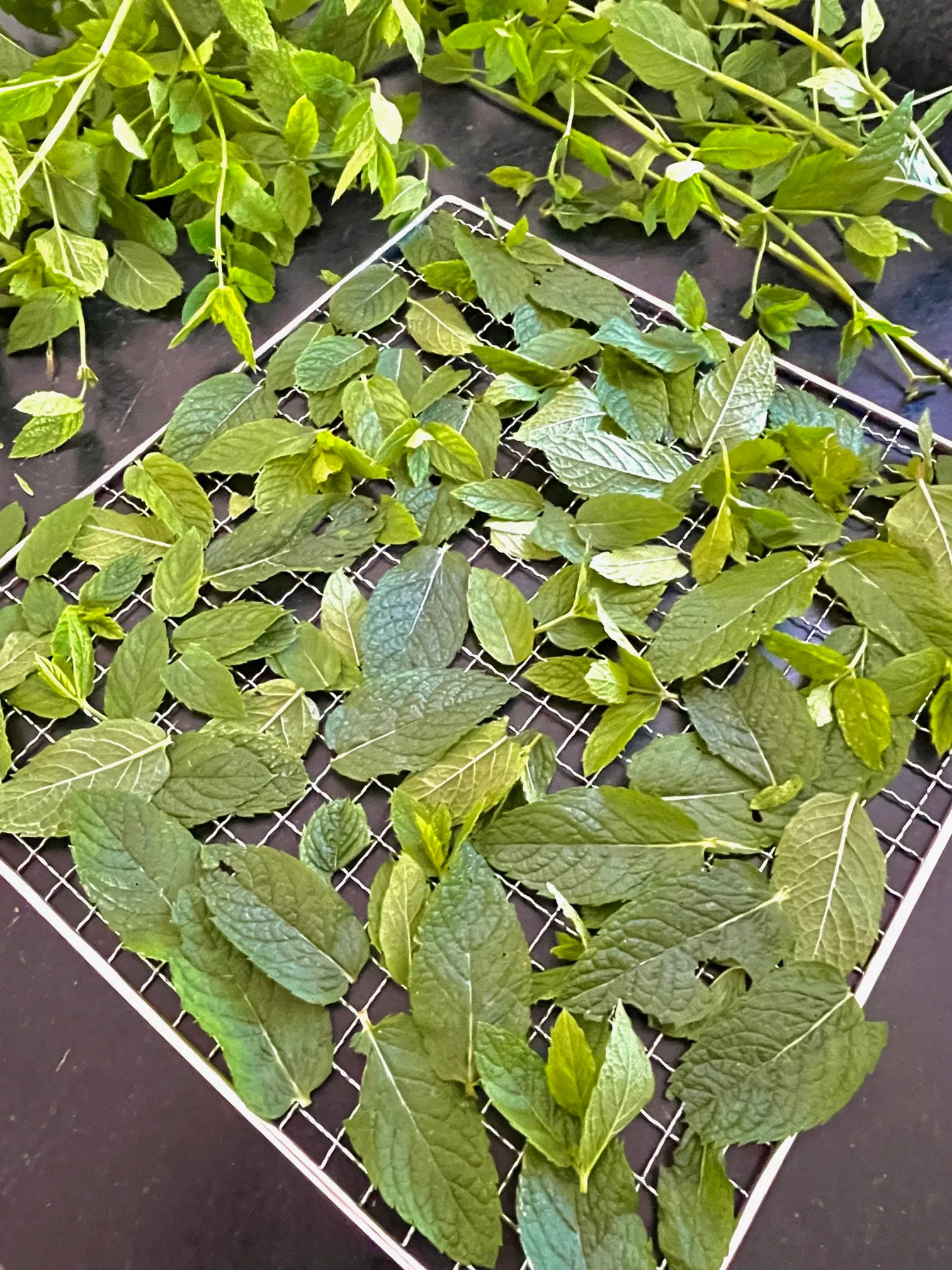
Cosori Stainless Steel Dehydrator
After years of waiting to take the plunge, I have finally purchased a Dehydrator — Visions of Dried Fruits Dance in My Head! I might even make some beef jerky–who knows? I know that I’ll dehydrate herbs & vegetables. Today, I am learning all about my new dehydrator, and I thought you might enjoy taking the ride with me.
My First Dehydrating Experiment Was with Drying Flowers:

Image Credit; Pacific Northwest Extension Publication #397

Image Credit; Pacific Northwest Extension Publication #397

-
Citric acidMix 1 teaspoon of citric acid into 1 quart of cold water. Soak the fruit for 10 minutes, then remove with a slotted spoon, drain, and dehydrate. Citric acid can help prevent browning and act as an antimicrobial. You can find citric acid in the canning section of most supermarkets.
-
Ascorbic acidMix 3¾ teaspoons of powdered ascorbic acid (or 20 crushed 500-milligram vitamin C tablets) into 2 cups of water. Soak the fruit for 10 minutes, then remove with a slotted spoon, drain, and dehydrate.
- Lemon juice Mix equal parts of bottled lemon juice and cold water. Soak the fruit for 10 minutes, then remove with a slotted spoon, drain, and dehydrate. Lemon juice can also help prevent browning and act as an antimicrobial. Google ai
 Image Credit; Pacific Northwest Extension Publication #397
Image Credit; Pacific Northwest Extension Publication #397
 Image Credit; Pacific Northwest Extension Publication #397
Image Credit; Pacific Northwest Extension Publication #397
 Image Credit; Pacific Northwest Extension Publication #397
Image Credit; Pacific Northwest Extension Publication #397

Image Credit; Pacific Northwest Extension Publication #397
Let’s Check Out Some Recipes First!

Image Credit: Cosori
 Image Credit: Cosori
Image Credit: Cosori
 Image Credit: Cosori
Image Credit: Cosori
 Image Credit: Cosori
Image Credit: Cosori
I had to purchase a Tigwin Apple Peeler, Slicer, and Corer for this recipe–and to make some apple pies, apple butter, jelly, tarts, etc.

Image Credit: Wintergreen
 Image Credit: Wintergreen
Image Credit: Wintergreen
 Image Credit: Wintergreen
Image Credit: Wintergreen

Image Credit: Wintergreen
How to Use Dehydrated Tomatoes
“Tomatoes rehydrate quickly so they can be used dry as they soften up with the moisture from other ingredients and leave a little pockets of “tomatoey” taste in your dish. However, if you do need them soft you can rehydrate by soaking in either warm water or good quality oil (olive oil is most common) for about 10 minutes.
Salads and Sandwiches:
“Rehydrate the tomatoes by marinating in a bit of salad dressing then enjoy tomatoes in your salad in the winter or on a sandwich. You can also puree them into your salad dressing to make a tomato vinaigrette.
Minced or Crumbled Dried Tomatoes
“Add to deviled egg filling
“Mix in scrambled eggs
“Use as a garnish with fish, chicken or vegetable dishes
“Add to biscuits, cornbread, savory muffins or waffles
“Add filling for stuffed peppers or cabbage
“Tomato Powder:
“Puree dried tomatoes into a powder and store in a jar. Use it to boost tomato flavor similar to tomato paste. Mix with water to form a paste. Tomato powder can be used in place of tomato paste when just 1 or 2 tablespoons are needed in a recipe. It is easy to end up wasting a can or jar tomato paste when just a bit is needed. Avoid waste with tomato powder.
“Whoops! Did you buy off season tomatoes hoping they would satisfy your craving? Sprinkle with tomato powder to boost flavor on tasteless tomatoes
“Mix 1:1 with some grated Parmesan cheese and sprinkle on popcorn or corn on the cob.
Tomato Chips:
“Drizzle olive oil and sprinkle salt on thinly sliced tomatoes. Dehydrate until crispy and serve as chips with pesto, aioli, or dip of your choice.
Sundried Tomato “Pesto”
“1/2 c dried tomatoes, 3/4 c water, 1/4 c nuts (pinenuts, almonds, walnuts) 1/4 c green herbs such as basil, cilantro or parsley 1/4 cup grated Parmesan cheese (optional) – pulse in food processor 3-4 times. With processor running, drizzle in olive oil until you reach the consistency you like (typically between 2 – 4 tablespoons). Season with salt and pepper.
“Use on pasta, pizza, as a sandwich spread, sauce for vegetables or eggs.” University of California Agriculture
 Image Credit: Cosori
Image Credit: Cosori
 Image Credit: Cosori
Image Credit: Cosori



Image Credit: Excalibur
 Image Credit: Cosori
Image Credit: Cosori
 Image Credit: Cosori
Image Credit: Cosori

Image Credit: Brod & Taylor
The following information is from Brod & Taylor
Dehydrated roses
Time: 12-14 hours
Temperature: 115ºF / 46ºC
Dehydrated Violets / Pansies
Time: 4-6 hours
Temperature: 115ºF / 46ºC
Dehydrated Marigolds / Sweet Peas
Time: 4-6 hours
Temperature: 115ºF / 46º

Image Credit: One Hundred Dollars a Month
Drying Mint Leaves In A Dehydrator
“First, gently rinse your mint leaves and gently shake them to remove excess water. Remove mint leaves from stems.
“Lay the leaves on the dehydrator trays in a single layer.
Set your dehydrator to 115 degrees and dehydrate for about 4 hours. {I own a Cosori Food Dehydrator.}
Every food dehydrator is a little different, so you may need to adjust your dehydrating time accordingly.
‘Basically, if the leaves crumble, they are ready to be removed from the dehydrator.
“Once your mint has been totally dehydrated, place the mint in an airtight container along with a
Drying Mint Leaves In A Dehydrator
First, gently rinse your mint leaves and gently shake them to remove excess water. Remove mint leaves from stems.
Lay the leaves on the dehydrator trays in a single layer.
Set your dehydrator to 115 degrees and dehydrate for about 4 hours. {I own a Cosori Food Dehydrator.}
Every food dehydrator is a little different, so you may need to adjust your dehydrating time accordingly.
Basically, if the leaves crumble, they are ready to be removed from the dehydrator.
Once your mint has been totally dehydrated, place the mint in an airtight container along with a food safe desiccant packet and store in a cool dry place.” One Hundred Dollars a Month
Discover more from Jacki Kellum
Subscribe to get the latest posts sent to your email.
 Image Credit: Cosori
Image Credit: Cosori
 Image Credit: Wintergreen
Image Credit: Wintergreen